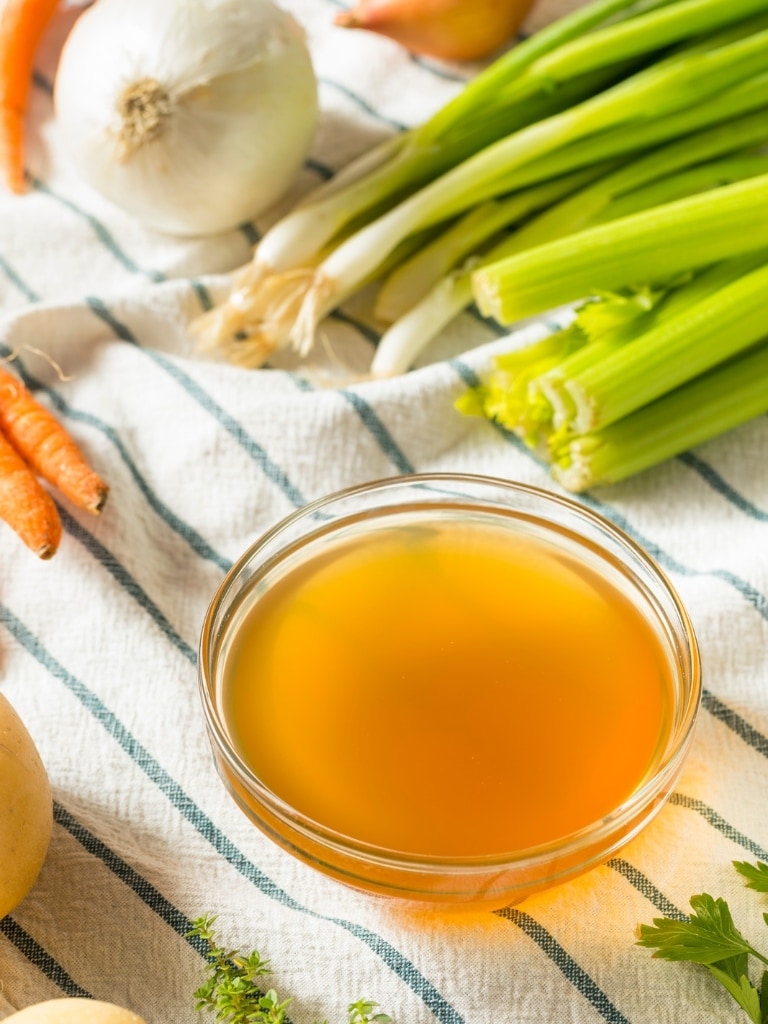How to Make Vegetable Broth Using Kitchen Scraps?
Homemade vegetable broth with vegetable scrapes is an incredible source of nutrients, full of readily assimilated vitamins and minerals. Save those leftover vegetable scraps! Instead, use them to make a healthy vegetable broth. It's cheaper and healthier than buying broth from the grocery store.

Note: You'll find valuable information before the recipe. If you're short on time, you may skip forward to the recipe!
Why should I make my vegetable broth?
When you buy vegetable broth or stock, you're going to get a product that's high in sodium but low in flavor. You can control the amount of sodium and make an unbelievably delicious base for many dishes that call for stock as the primary cooking liquid by making your stock.
A cup of vegetable broth from the store could have 540 mg of sodium in it. Is that how you would like to begin a homemade soup? Examine the labels on some packaged soups and broths the next time you are at the grocery store. Make yourself aware of the potentially excessive amounts of sodium you are consuming.
What is the difference between vegetable stock and broth?
According to many sources, vegetable broth is seasoned, while stock is not. However, in the modern American market (grocery store), the terms are interchangeable, and both frequently contain salt.
For everyday cooking, they can be used interchangeably. If you're going to reduce any of them for sauces, make sure you're using stock, not broth, and that it's low in sodium. Otherwise, the water will evaporate and the remaining liquid will be too salty. Making your stock is the best way to ensure this.
What is sodium? Is it the same thing as salt?
Sodium is a mineral that can be found in a variety of foods. For normal muscle and nerve function, your body requires sodium. It also aids in the maintenance of body fluid balance. The majority of table salts are made from sodium chloride. As a result, salt used in cooking or flavoring foods usually contains sodium. Furthermore, healthcare providers frequently use the terms sodium and salt interchangeably.h
Table salt is made up of roughly 40% sodium and 60% chloride. Sodium chloride accounts for approximately 90% of the sodium we consume. The remainder is derived from other sources of sodium, such as baking soda. These sodium-containing ingredients are used in food to preserve it, improve its color, add flavor, or make it firmer.
Is sodium harmful?
Even though you need some sodium, too much of this mineral could be harmful to your health. Regular consumption of foods high in sodium can make your body retain more water. Additionally, your organs have to work harder as a result of the extra body water. This raises your chance of hypertension, which can impair the health of your heart and kidneys.
What foods contain sodium?
Natural sources of sodium include celery, beets, and milk. Sodium levels in packaged and prepared foods, particularly soups, can be high. The majority of that sodium comes from processed food. Adding more salt increases sodium intake.
How much sodium should we consume?
An adequate daily sodium intake of 1,500 milligrams has been established for adults, but most people consume more than that amount.
What is the way to cut back on our sodium intake?
When we cook a little more, we can alter our sodium intake and the quality of our vegetables.
The Nutrition Facts label is the most reliable source of information about the sodium content of specific foods: Look for foods with less sodium on the label. Select foods that have fewer than 120 mg of sodium per serving. On the label, look for the phrases "low sodium," "very low sodium," and "salt-free." If a food's label says unsalted, no salt added, reduced sodium, or lower sodium, you should double-check its sodium content. These products might still contain a lot of sodium.
What veggie scraps should I select for my broth?
A flavorful stock can be made from a variety of scraps. Some examples include leek tops, fennel fronds, carrot tops, herb stems, corn cobs, mushroom stems, scallion roots or tops, onion skins and ends, and garlic skins and ends.
Trimmings (such as mushroom stems and onion ends) can be saved, as should anything that is about to go bad but you won't use otherwise, such as limp carrot or celery. Aside from using frozen scraps, making homemade vegetable broth is an excellent opportunity to clean.
Here is a list of some suggested vegetable scraps that are high in nutrients:
- Onion Skins: Rich in antioxidant-rich flavonoid quercetin, onion skins also impart a mild flavor.
- Carrot tops: Vitamin K and C are especially abundant in carrot greens.
- Celery leaves: Rich in vitamins A, C, and K, these leaves are bursting with flavor.
- Mushroom stems: Rich in B vitamins, particularly riboflavin, mushroom stems have a strong umami flavor.
- Garlic: Garlic cloves have several health advantages, including the ability to strengthen immunity. They can be used with their peels.
- Leeks: You can use leek greens, which are high in vitamins A and K.
- Bell pepper cores: The broth can benefit from the mild sweetness imparted by the nutritious bell pepper cores.
- Ginger: You can add leftover ginger to your broth to give it a spicy, comforting flavor and possibly even some anti-inflammatory properties.
- Herbs: In addition to adding flavor, herbs like bay leaves, thyme, and rosemary also contain a variety of vitamins and minerals.
What should you be aware of?
Although there are some possible risks, homemade vegetable broth made from scraps is usually quite safe to eat. Beware of veggies that may contain harmful amounts of pesticides and heavy metals.
It's also critical to follow safe food handling and storage practices when handling scraps to prevent introducing bacteria into the food supply.
Avoid using vegetable scraps from cruciferous vegetables such as broccoli, cabbage, or cauliflower because they can make your broth bitter.
Note: Even though the main purpose and benefit of making a homemade vegetable broth using kitchen scraps is to use up leftover kitchen scraps, there's nothing wrong with incorporating some fresh ingredients as well especially if you don't have a lot of saved scraps or much variety to work with.
Tips
- If you don't have fresh or frozen herbs, season with a pinch of dry Italian seasoning. Add one or two bay leaves, fresh or dried.
- Do you have any canned tomatoes on hand? You are welcome to add crushed tomatoes or homemade tomato paste to the mixture.
- Use a small amount of coconut oil or olive oil, especially if you decide to sauté the fresh ingredients first.
- Add a sprinkle of nutritional yeast to make a more nutritional broth.
What is nutritional yeast?
Nutritional yeast has grown in popularity in recent years, coinciding with the growing interest in plant-based diets. These golden flakes are made with yeast that is similar to that used in brewing and baking, but it has been deactivated in the final product.
Many vegetable dishes benefit from that extra kick of flavor. If you've never tried it, you'll be amazed at how much flavor it can add to a dish. This is something I would not leave out.
Nutritional yeast is high in nutrients that vegetarian and vegan diets often lack. It's also gluten-free, soy-free, and sugar-free, making it an excellent dietary addition for people with food intolerances. However, studies show that its nutritional value can benefit any diet.
Nutritional yeast is high in vitamins and minerals. It also contains all nine essential amino acids, resulting in a complete protein similar to that found in animal products..
How to collect kitchen scraps?
Store the saved veggie scraps in freezer bags or freezer-safe containers. Depending on how much and how often you cook, as well as how large a batch of broth you intend to make, you may be able to save enough scraps to make homemade vegetable broth in a couple of weeks - or it may take a couple of months. It's entirely up to you, and either way is fine!
Check also this recipe to make vegetable broth using whole vegetables.
Note: Examine the nutrition label for an overview of this recipe’s nutritional profile. A nutrient is considered low if the label lists less than 5% of its daily value, while 20% or more is considered high. In general, you should limit your intake of saturated fat, cholesterol, and sodium while increasing your intake of fiber, vitamins, and minerals.
- scallion tops,
- carrot tops and peels
- parsnip tops and peels
- turnip greens and peels
- leek tops and peels
- fennel fronds and stalks
- corn cobs
- onion tops and bottoms
- mushroom stems
- zucchini tops
- 1 head of garlic
- 1/2 pound celery (about 227 gr or 3-4 stalks)
- 1/2 bunch of parsley
- 1/2 bunch of coriander
- 1/2 bunch of dill
- 1/2 bunch of basil
- 1 sprigs of thyme
- 2 sprig of rosemary
- 2 bay leaves
- 1 teaspoon pepper corns
- 1 teaspoon coriander seeds
- 1 teaspoon ginger (or leftovers)
- 1 teaspoon turmeric (or leftovers)
- 1 teaspoon salt
- 1/4 cup nutritional yeast
- 1 gallon or 3.78 liters (16 cups)
In a 6-quart stock pot, combine the vegetable scraps. Mix in the remaining ingredients and water. There should be enough water in the pot to easily stir the vegetables.
Cover and bring to a boil. Lower the heat to a low simmer and cook, stirring occasionally, for one hour while keeping the lid on.
Remove the pot from the heat and use a slotted spoon or a skimmer to remove all of the vegetables.
Pour the broth through a strainer into a large bowl. The broth should be free of impurities and clean.
Allow to cool completely at room temperature before dividing into storage containers or gallon freezer bags. Refrigerate for up to one week or freeze for up to three months.
Serving Size 1 cup
- Amount Per Serving
- Calories 198.5kcal
- Calories from Fat 5.57kcal
- % Daily Value *
- Total Fat 0.66g2%
- Saturated Fat 0.13g1%
- Sodium 229mg10%
- Potassium 436mg13%
- Total Carbohydrate 12g4%
- Dietary Fiber 3.28g14%
- Sugars 2.2g
- Protein 2.54g6%
- Vitamin A 3061 IU
- Vitamin C 29.47 mg
- Calcium 117 mg
- Iron 2.64 mg
- Vitamin K 192.29 mcg
- Manganese 0.6 mg
* Percent Daily Values are based on a 2,000 calorie diet. Your daily value may be higher or lower depending on your calorie needs.
This recipe makes about 14 cups broth.



